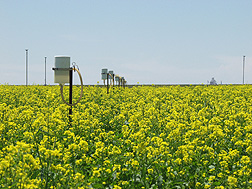This page has been archived and is being provided for reference purposes only. The page is no longer being updated, and therefore, links on the page may be invalid.
| Read the magazine story to find out more. |
|
|
|
|
Great Plains Producers Could Profit from Spring Canola Crops
By Ann PerryOctober 31, 2013
Computer modeling by scientists at the U.S. Department of Agriculture (USDA) suggests that spring canola has the potential to become a profitable bioenergy crop for farmers in the semi-arid Central Great Plains.
The research by Agricultural Research Service (ARS) agronomist David Nielsen and others could provide producers with alternatives for stretching scarce water supplies and increasing cash crop production. ARS is USDA's chief intramural scientific research agency, and this work supports the USDA priority of developing new sources of bioenergy.
Nielsen, who works at the ARS Central Great Plains Research Station in Akron, Colo., worked with colleagues to combine existing plant growth computer models and generate spring canola production simulations. Then they ran their results from the combined model with 16 years of regional weather data, four different soil water levels at planting time, and other site-specific information to generate spring canola yield estimates for nine locations in Nebraska, Colorado and Kansas.
Results from their crop simulations suggested the highest yields would be produced in the north-central area near Champion, Neb., and the lowest yields would be produced in the south-central area near Walsh, Colo. When 75 percent of the soil water was available for crop use at planting, the model indicated six of the sites had more than a 70 percent probability of producing a canola seed yield of at least 900 pounds per acre.
Using the average simulated yields at each location, the researchers ran an economic analysis that indicated average net returns could range from $67 to $189 per acre, depending on plant-available soil water levels. Simulations produced positive average net returns for five sites: Garden City and Tribune City, Kan.; and Champion, McCook and Sidney, Neb. These positive net returns were predicted even when only 25 percent of the soil water was available for crop use at planting.
Nielsen used these simulation results to develop a simple decision support tool for canola production and economic analysis that can be used by farmers for canola planning.
Results from this work were published in 2012 in Agronomy Journal.
Read more about this project in the October 2013 issue of Agricultural Research magazine.

